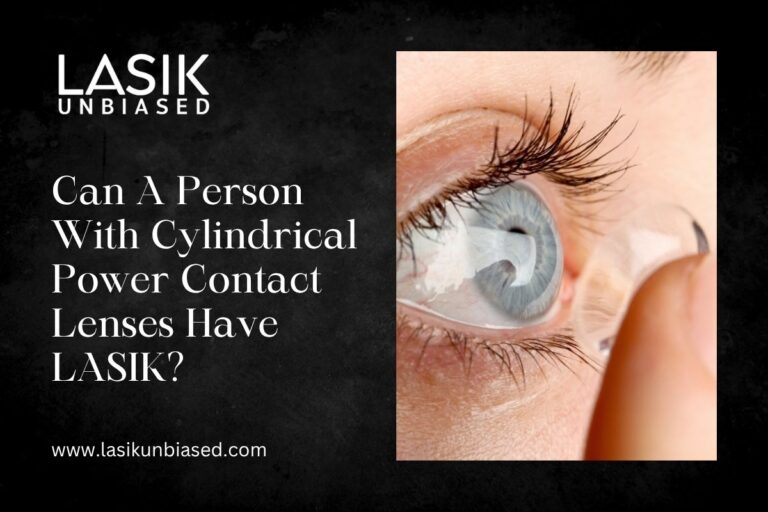Yes, a person with cylindrical power who wears contact lenses can have LASIK, provided they meet certain criteria for astigmatism correction and overall eye health.
LASIK is a proven, safe, and highly effective procedure for correcting mild to moderate cylindrical power (astigmatism), but not everyone is a candidate, and the details matter.
If you’re using toric or cylindrical contact lenses and want to know if LASIK is right for you, this guide will walk you through eligibility, what LASIK can correct, the process, and what to expect before and after surgery.
Understanding Cylindrical Power and Astigmatism
Cylindrical power refers to astigmatism, a common refractive error where the cornea or lens is shaped more like a football than a sphere. This uneven shape stops light from focusing properly on the retina, leading to blurred or distorted vision.
People with astigmatism often need special “toric” contact lenses or glasses with a cylindrical prescription to see clearly.
How LASIK Corrects Cylindrical Power?
LASIK (Laser-Assisted In Situ Keratomileusis) is designed to treat refractive errors, including astigmatism, by reshaping the cornea to a more regular, symmetrical shape.
During the procedure, the surgeon creates a thin flap in the cornea, uses a laser to remove precise amounts of tissue, and then repositions the flap. This changes how light enters your eye, correcting the focusing problem caused by astigmatism.
What Levels of Cylindrical Power Can LASIK Correct?
- Mild to moderate astigmatism (up to 6 diopters) is generally treatable with LASIK.
- Mild astigmatism (as low as 0.5–0.75 diopters) can also be corrected with LASIK.
- If your astigmatism is too high or your corneas aren’t suitable for LASIK, your doctor may consider alternatives like PRK, which have similar correction limits but may be better suited depending on your eye structure.”
Am I Eligible for LASIK If I Have Cylindrical Power?
Key Criteria for LASIK Candidates
- Stable Prescription: Your prescription for glasses or contact lenses needs to be consistent and unchanged for at least a full year before proceeding.
- Age: You must be at least 18 years old to qualify.
- Astigmatism Severity: LASIK is best for mild to moderate astigmatism (up to 6 diopters).
- Corneal Thickness: Your cornea must be thick enough for safe reshaping.
- Healthy Eyes: No active eye diseases, severe dry eye, or corneal scarring.
- No Pregnancy or Breastfeeding: Hormonal changes can affect vision stability.
Wearing cylindrical power contact lenses does not disqualify you from LASIK, but you’ll need to stop wearing them for a period before your pre-surgery evaluation. This “washout” period lets your cornea return to its natural shape so your measurements are accurate.
What to Expect? The LASIK Evaluation Process
- Contact Lens Washout: Stop wearing soft contact lenses for at least 1 week, or toric/hard lenses for 2–3 weeks before your evaluation.
- Comprehensive Eye Exam: Your ophthalmologist will check your prescription, corneal thickness, topography, and overall eye health.
- Customised LASIK Planning: If you’re eligible, your surgeon will plan the laser correction based on your unique corneal shape and prescription.
- Discussion of Alternatives: If LASIK isn’t suitable due to factors like corneal thickness or eye health, your doctor may recommend other procedures, such as PRK or SMILE, based on your specific needs.
How Effective Is LASIK for Cylindrical Power?
- High Success Rate: More than 90% of LASIK patients with astigmatism attain 20/20 vision or better.
- Quick Recovery: Most people notice improved vision within 24–48 hours, with full results in a few weeks.
- Long-Lasting Results: For stable prescriptions, LASIK results are typically permanent, though some may need enhancements later in life.
Benefits of LASIK for People with Cylindrical Power
- Freedom from Glasses and Contacts: Many people can stop using corrective lenses altogether.
- Clearer, Sharper Vision: LASIK can correct both spherical and cylindrical errors, leading to crisper vision.
- Fast, Comfortable Recovery: The majority of patients resume their usual activities within one or two days.
Limitations and Risks
- Not for Everyone: Very high astigmatism, thin corneas, or certain eye diseases may make LASIK unsuitable.
- Side Effects: Temporary dry eyes, glare, halos, or double vision can occur, but these usually resolve within a few months.
- Residual Astigmatism: Some patients may need minor enhancements or continue using low-power glasses for certain tasks.
Alternatives If You’re Not a Candidate
- PRK (Photorefractive Keratectomy): Surface-based laser surgery, good for thinner corneas.
- SMILE: Minimally invasive laser procedure, suitable for certain types of astigmatism.
Mini How-To: Preparing for LASIK with Cylindrical Power
- Schedule a consultation with a refractive surgeon.
- Stop wearing your contact lenses as advised.
- Bring your glasses and a record of your prescriptions to your appointment.
- Ask about all your options—LASIK, PRK, SMILE, and ICL.
- Talk to your doctor about your vision goals and any questions or concerns you may have.
Key Takeaways and Next Steps
If you wear cylindrical power contact lenses, you can likely have LASIK if your astigmatism is mild to moderate, your prescription is stable, and your eyes are healthy.
The best way to know for sure is to schedule a comprehensive evaluation with an experienced LASIK surgeon. With the right preparation and expert care, you could soon enjoy clear, crisp vision without the need for glasses or contacts.
Frequently Asked Questions
Can LASIK remove cylindrical power completely?
Yes, for most people with mild to moderate astigmatism, LASIK can fully correct cylindrical power, but results depend on your prescription and eye health.
Is there a minimum or maximum cylindrical power for LASIK?
No minimum, but LASIK is most effective for 0.5 to 6 diopters.
Should I stop wearing contact lenses before having LASIK?
Yes. You must stop wearing soft lenses for at least a week, and toric or hard lenses for 2–3 weeks, before your evaluation to ensure accurate measurements.
Will LASIK help if I have both spherical and cylindrical power?
Yes, LASIK can correct both types of refractive error in a single procedure, provided you meet all other criteria.


